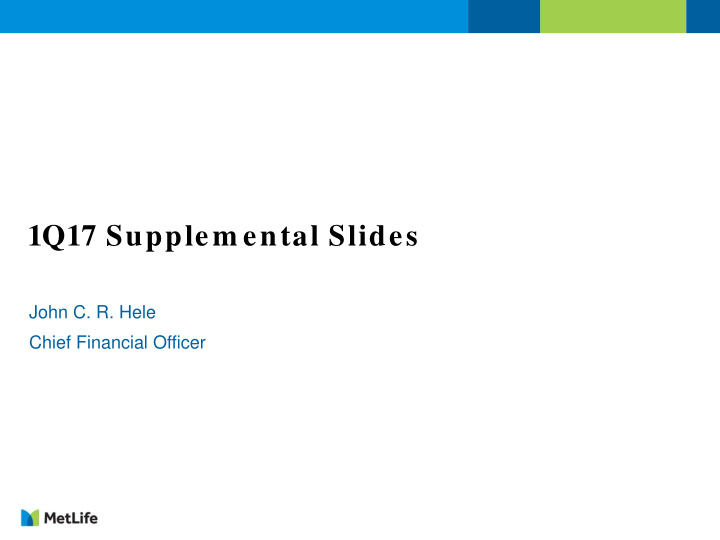



1Q17 Supplem ental Slides John C. R. Hele Chief Financial Officer
Table of Contents Page Effect of Derivative Losses…………………………..…………. 3 Net Derivative Gains (Losses)…………………………………. 4 Explanatory Note on Non-GAAP Financial Information……… 5 2
Effect of Derivative Losses (In millions) – Post-tax 1Q17 Net Income (Loss) $820 5 Less: Net Investment Gains (Losses) (602) Less: Net Derivative Gains (Losses) (139) Less: Investment Hedge Adjustments 10 Less: Other Operating Earnings* $1,546 *Available to common shareholders. 3 See Explanatory Note on Non-GAAP Financial Information for non-GAAP financial information, definitions and/or reconciliations.
Net Derivative Gains (Losses) (In millions) – Post-tax RemainCo 1 Brighthouse Financial Total Company 1Q17 1Q17 1Q17 Asymmetrical and Asymmetrical and Asymmetrical and Reported Reported Reported Non-Economic Non-Economic Non-Economic Non-VA Program Interest Rate (109) (163) (17) (62) (126) (225) Foreign Currency Exchange Rate 81 70 (32) (34) 49 36 Other 1 (8) (72) - (71) (8) Total Non-VA Program $(27) $(101) $(121) $(96) $(148) $(197) VA Program Market Risks in Embedded Derivatives 175 - 444 - 619 - Freestanding Derivatives 2 (240) (27) (695) (150) (935) (177) Nonperformance Risks in Embedded (2) (2) (26) (26) (28) (28) Derivatives Other Risks in Embedded Derivatives (53) - (57) - (110) - Total VA Program $(120) $(29) $(334) $(176) $(454) $(205) Subtotal $(147) $(130) $(455) $(272) $(602) $(402) One-time Recapture 172 - (172) - - - Total Net Derivative Gains (Losses) $25 $(130) $(627) $(272) $(602) $(402) 1 Includes U.S., Asia, Latin America, EMEA and MetLife Holdings reporting segments, as well as Corporate & Other. 2 Used to hedge embedded derivatives. 4 See Explanatory Note on Non-GAAP Financial Information for non-GAAP financial information, definitions and/or reconciliations.
Explanatory Note on Non-GAAP Financial Inform ation Any references in this presentation (except in this Explanatory Note on Non-GAAP Financial Information) to: should be read as, respectively: (i) net income (loss); and (i) net income (loss) available to MetLife, Inc.’s common shareholders; and (ii) operating earnings. (ii) operating earnings available to common shareholders. In this presentation, MetLife presents certain measures of its performance that are not calculated in accordance with accounting principles generally accepted in the United States of America (“GAAP”). MetLife believes that these non-GAAP financial measures enhance the understanding of MetLife’s performance by highlighting the results of operations and the underlying profitability drivers of the business. The following non-GAAP financial measures should not be viewed as substitutes for the most directly comparable financial measures calculated in accordance with GAAP: Non-GAAP financial measures: Comparable GAAP financial measures: (i) operating earnings available to common shareholders (i) net income (loss) available to MetLife, Inc.’s common shareholders Reconciliation of this non-GAAP measure to the most directly comparable GAAP measure is included in this presentation and in this period’s quarterly financial supplement, which is available at www.metlife.com. MetLife’s definitions of the various non-GAAP and other financial measures discussed in this news release may differ from those used by other companies: 5
Explanatory Note on Non-GAAP Financial Inform ation (Continued) Operating earnings and related measures • operating earnings available to common shareholders These measures are used by management to evaluate performance and allocate resources. Consistent with GAAP guidance for segment reporting, operating earnings is also MetLife’s GAAP measure of segment performance. Operating earnings and other financial measures based on operating earnings are also the measures by which MetLife senior management’s and many other employees’ performance is evaluated for the purposes of determining their compensation under applicable compensation plans. Operating earnings and other financial measures based on operating earnings allow analysis of our performance relative to our business plan and facilitate comparisons to industry results. Operating earnings is defined as operating revenues less operating expenses, both net of income tax. Operating earnings available to common shareholders is defined as operating earnings less preferred stock dividends. Operating revenues and operating expenses These financial measures, along with the related operating premiums, fees and other revenues, focus on our primary businesses principally by excluding the impact of market volatility, which could distort trends, and revenues and costs related to non-core products and divested businesses and certain entities required to be consolidated under GAAP. Also, these measures exclude results of discontinued operations and other businesses that have been or will be sold or exited by MetLife and are referred to as divested businesses. In addition, for the year ended March 31, 2016, operating revenues and operating expenses exclude the financial impact of converting MetLife’s Japan operations to calendar-year end reporting without retrospective application of this change to prior periods and is referred to as lag elimination. Operating revenues also excludes net investment gains (losses) (NIGL) and net derivative gains (losses) (NDGL). Operating expenses also excludes goodwill impairments. The following additional adjustments are made to revenues, in the line items indicated, in calculating operating revenues: • Universal life and investment-type product policy fees excludes the amortization of unearned revenue related to NIGL and NDGL and certain variable annuity guaranteed minimum income benefits (GMIB) fees (GMIB fees); • Net investment income: (i) includes earned income on derivatives and amortization of premium on derivatives that are hedges of investments or that are used to replicate certain investments but do not qualify for hedge accounting treatment (“investment hedge adjustments”), (ii) excludes post-tax operating earnings adjustments relating to insurance joint ventures accounted for under the equity method, (iii) excludes certain amounts related to contractholder-directed unit-linked investments, and (iv) excludes certain amounts related to securitization entities that are variable interest entities (VIEs) consolidated under GAAP; and • Other revenues are adjusted for settlements of foreign currency earnings hedges. 6
Recommend
More recommend